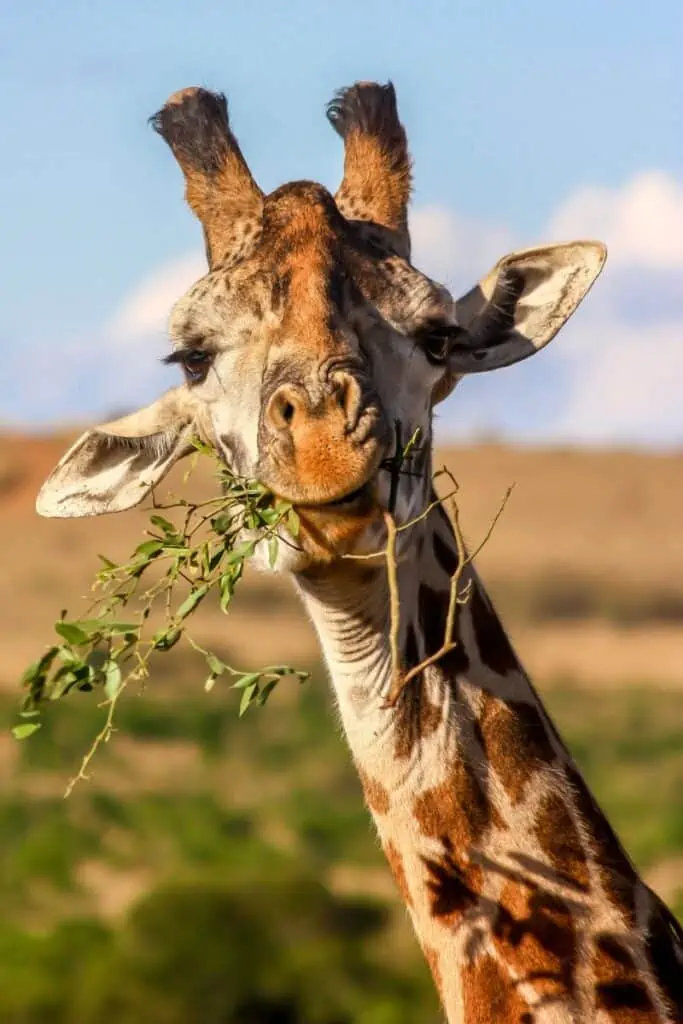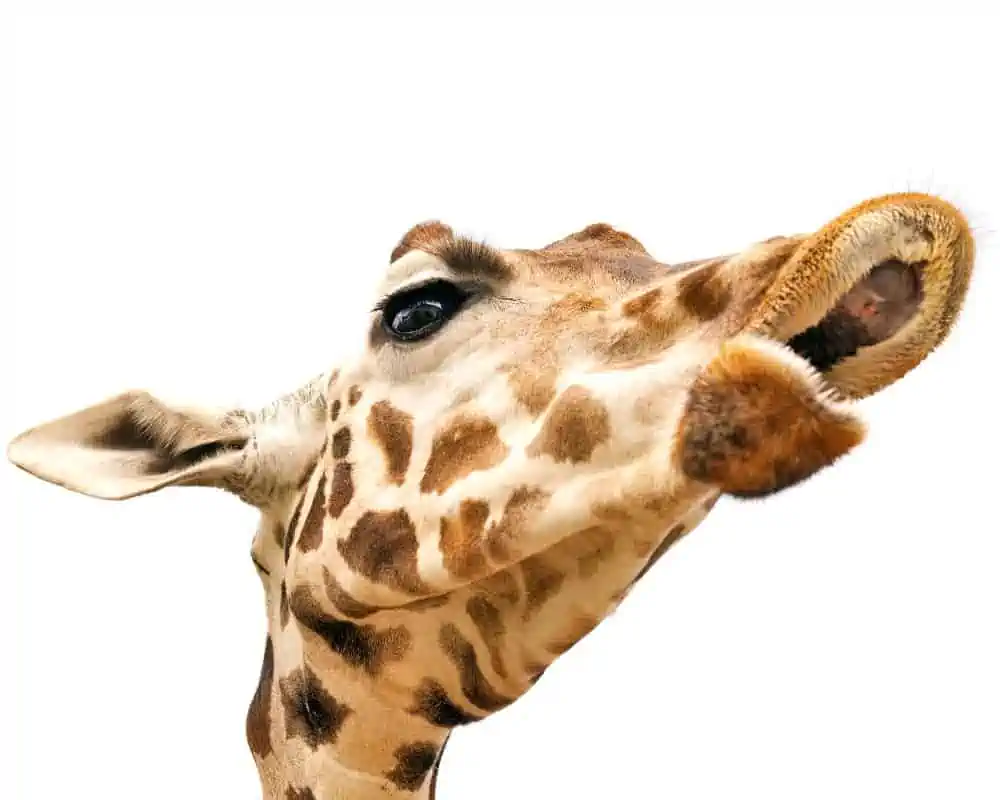If you’ve ever watched a giraffe chew on some Acacia leaves, you won’t be alone wondering, do giraffes have teeth?
Giraffes have teeth, but they are missing the upper incisors that many mammals have and are often the most visible in the mouth. They have more molars at the back of their mouth, which are used for grinding up their food. They have 32 teeth in total – the same as humans, although the layout is very different.
In this article, we’ll check out what giraffe teeth look like, what kind they have (and why), plus some other cool and interesting facts about a giraffe’s mouth and how it processes its food.

What type of teeth does a giraffe have?
Giraffes have large, flat, strong teeth explicitly designed for grinding up leaves, thorns, twiggy bits of vegetation, and fruit.
Giraffes are browsers that feed on a wide variety of plant matter, and they will eat all kinds of different things, so they need teeth capable of tackling different textures and breaking them up into small pieces.
If you examined a single giraffe tooth, its shape and size would depend on its location in the mouth. Giraffes have two primary types of teeth: incisors and molars.
The incisors, like human incisors, are designed for cutting up food and slicing pieces away from the food source. They are strong, sharp, and designed to strip vegetation off bushes and break it into more manageable chunks.
By contrast, the molars are flat and plate-like. Like human molars, their job is to do the grinding, breaking up the vegetation, and chewing it into a more pleasing mass.
It may still be rough when the giraffe swallows, but it should be partially chewed. Between these two kinds of teeth, the giraffe is well equipped to handle its diet.
How many teeth does a giraffe have?
A giraffe has 32 teeth, but they aren’t positioned throughout the mouth the way that human teeth are.
Instead, they are mostly grouped at the back of the jaw, where there is more biting and grinding strength. This makes it easier for giraffes to grind up the vegetation they eat.
The giraffe’s mouth also has a few other noticeable features:
- Giraffes have a very long tongue that helps to grasp and pick vegetation, as well as move it around in the mouth so that it meets the teeth.
- They have tough, leathery lips that help them to eat all kinds of foods, even thorny plants.
- There is a gap between their front teeth and their back molars which is quite long. They do most of their chewing in the back of the mouth.
- Instead of front incisors, giraffes have a large and rigid “dental pad” that assists them in getting large amounts of plants into their mouths.
How do giraffes eat?
As the upper front teeth of a giraffe are missing, it can close its leathery lips around a branch, with the branch inside its mouth. It then presses its tongue against the branch, ensuring that the branch rests against that grinding dental pad we mentioned before.
Next, the giraffe can pull back its head, and the dental pad will strip the foliage off the branch, pulling away lots of leaves very efficiently. These can be processed a little by the incisors and then passed to the back of the mouth for the molars to tackle.

The giraffe can take in a lot of vegetation at once using this method – and may consume up to 75 pounds (34 kg) of food per day.
Giraffes may spend several minutes grinding the leaves and then pass them down into its stomach. Like other ruminants, they can bring the food back up for further chewing when there is no nearby food source. This makes them better able to watch for predators because they can chew with their heads up (without worrying about throwing up).
Giraffes may appear to be very different from animals like deer, but they eat similarly and use some of the same adaptations to improve their chances of survival in the wild.
Why are giraffes missing their front incisors?
Giraffes are missing these incisors because they don’t need them and because not having them makes the giraffe a more efficient eater. To use incisors, the giraffe would need to line its teeth up with the specific stems of the foliage that it wanted to eat, and this would be much more time-consuming.
Instead, the giraffe can simply strip all of the foliage off the branch by using its dental pad. The efficiency is massively increased.

Because giraffes are such large animals, they need to eat a lot to survive – so they need this efficiency boost. If they had to stop to chew every leaf off the trees, it would be challenging to consume enough for them to survive.
If giraffes did not have the rugged ridge of tissue that forms the dental pad at the front of their mouths, they would not be able to strip vegetation off trees. With this in place, though, they are well positioned to do so.
Because they often eat thorny bushes that might damage their mouths, this dental pad is handy.
What does a giraffe tooth look like?
A giraffe tooth looks similar to a human tooth, although considerably bigger. Their incisors and molars serve the same purpose as a human’s incisors and molars, and they are not designed in a significantly different way.
They are also similar to the teeth of other browsing animals, such as deer.
The teeth are tough, and they are ideal for grinding up plant matter of all varieties.
As mentioned, they do not have long canine teeth. Instead, they have long incisors, which measure around 45mm from the crown to the root (or about four times the length of human incisors).

Final thoughts on giraffe teeth
Giraffes certainly have teeth, and like many other browsing animals, they depend on these to help grind up their food to extract the nutrients from it.
Their teeth are a lot larger than human teeth, and they are adapted to help the giraffe strip foliage from branches quickly and efficiently.
They lack front incisors on the tops of their mouths, but this is not a disadvantage to the giraffe – in fact, it makes them more efficient eaters.
They can strip all of the leaves of a branch in one go without having to stop and chew each one individually, thanks to the dental pad in place of where incisors would be.
